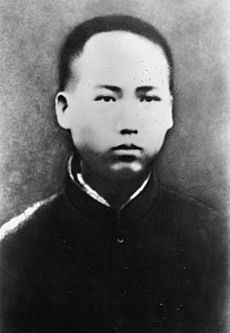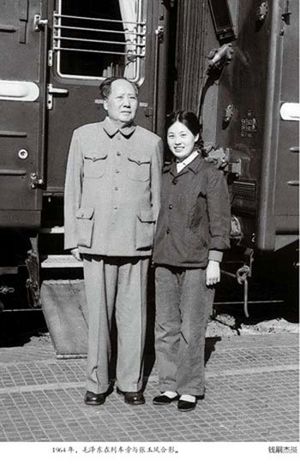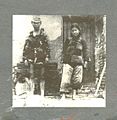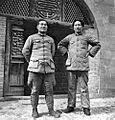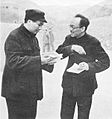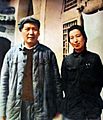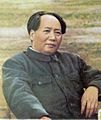Mao Zedong facts for kids
Quick facts for kids
Mao Zedong
|
|||||||||||||||||||||||||||||||||
|---|---|---|---|---|---|---|---|---|---|---|---|---|---|---|---|---|---|---|---|---|---|---|---|---|---|---|---|---|---|---|---|---|---|
| 毛泽东 | |||||||||||||||||||||||||||||||||
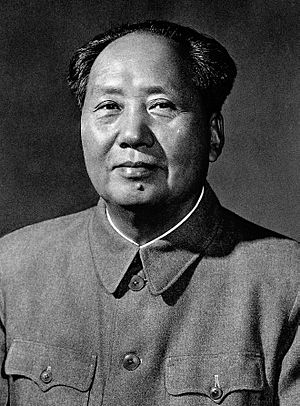
Official portrait, 1959
|
|||||||||||||||||||||||||||||||||
| Chairman of the Communist Party of China | |||||||||||||||||||||||||||||||||
| In office 20 March 1943 – 9 September 1976 |
|||||||||||||||||||||||||||||||||
| Deputy | Liu Shaoqi Lin Biao Zhou Enlai Hua Guofeng |
||||||||||||||||||||||||||||||||
| Preceded by | Zhang Wentian (as General Secretary) | ||||||||||||||||||||||||||||||||
| Succeeded by | Hua Guofeng | ||||||||||||||||||||||||||||||||
| 1st Chairman of the People's Republic of China | |||||||||||||||||||||||||||||||||
| In office 27 September 1954 – 27 April 1959 |
|||||||||||||||||||||||||||||||||
| Premier | Zhou Enlai | ||||||||||||||||||||||||||||||||
| Deputy | Zhu De | ||||||||||||||||||||||||||||||||
| Succeeded by | Liu Shaoqi | ||||||||||||||||||||||||||||||||
| Chairman of the Central Military Commission | |||||||||||||||||||||||||||||||||
| In office 8 September 1954 – 9 September 1976 |
|||||||||||||||||||||||||||||||||
| Deputy | Zhu De Lin Biao Ye Jianying |
||||||||||||||||||||||||||||||||
| Succeeded by | Hua Guofeng | ||||||||||||||||||||||||||||||||
| Chairman of the Central People's Government | |||||||||||||||||||||||||||||||||
| In office 1 October 1949 – 27 September 1954 |
|||||||||||||||||||||||||||||||||
| Premier | Zhou Enlai | ||||||||||||||||||||||||||||||||
| Personal details | |||||||||||||||||||||||||||||||||
| Born | 26 December 1893 Shaoshan, Hunan, Qing dynasty |
||||||||||||||||||||||||||||||||
| Died | 9 September 1976 (aged 76) Beijing, People's Republic of China |
||||||||||||||||||||||||||||||||
| Resting place | Chairman Mao Memorial Hall, Beijing | ||||||||||||||||||||||||||||||||
| Political party | Communist Party of China (1921–1976) | ||||||||||||||||||||||||||||||||
| Other political affiliations |
Kuomintang (1925–1926) | ||||||||||||||||||||||||||||||||
| Spouses |
|
||||||||||||||||||||||||||||||||
| Children | 10, including: Mao Anying Mao Anqing Mao Anlong Yang Yuehua Li Min Li Na |
||||||||||||||||||||||||||||||||
| Parents |
|
||||||||||||||||||||||||||||||||
| Alma mater | Hunan First Normal University | ||||||||||||||||||||||||||||||||
| Signature | |||||||||||||||||||||||||||||||||
| Chinese name | |||||||||||||||||||||||||||||||||
| Simplified Chinese | 毛泽东 | ||||||||||||||||||||||||||||||||
| Traditional Chinese | 毛澤東 | ||||||||||||||||||||||||||||||||
|
|||||||||||||||||||||||||||||||||
| Courtesy name | |||||||||||||||||||||||||||||||||
| Simplified Chinese | 润之 | ||||||||||||||||||||||||||||||||
| Traditional Chinese | 潤之 | ||||||||||||||||||||||||||||||||
|
|||||||||||||||||||||||||||||||||
|
Central institution membership
1964–1976: Member, National People's Congress
1954–1959: Member, National People's Congress 1938–1976: Member, 6th, 7th, 8th, 9th, 10th Politburo 1938–1976: Member, 6th, 7th, 8th, 9th, 10th Central Committee Other offices held
1954–1959: Chairman of the People's Republic of China
1954–1976: Chairman, CPC Central Military Commission 1954–1959: President and Chairman, National Defence Council 1954–1976: Honorary Chairman, CPPCC National Committee 1949–1954: Chairman, Central People's Revolutionary Military Commission 1949–1954: Chairman, CPPCC National Committee 1949–1954: Chairman, PRC Central People's Government 1943–1956: Chairman, CPC Central Secretariat 1936–1949: Chairman, CPC Central Military Commission |
|||||||||||||||||||||||||||||||||
Mao Zedong (born December 26, 1893 – died September 9, 1976), also known as Chairman Mao, was a Chinese leader, thinker, and military planner. He was a communist revolutionary who founded the People's Republic of China (PRC). Mao was the chairman of the Chinese Communist Party from the time the PRC was created in 1949 until his death in 1976. His ideas and plans are known as Maoism.
Contents
Early Life and Education
Mao Zedong was born on December 26, 1893, in Shaoshan village, Hunan, China. His father, Mao Yichang, was a farmer who became quite wealthy.
Mao's father was very strict with him and his three siblings. At age 8, Mao went to Shaoshan Primary School where he learned about Confucianism. He later said he didn't enjoy the old Chinese texts that taught Confucian ideas. Instead, he liked reading classic novels like Romance of the Three Kingdoms and Water Margin.
At age 13, Mao finished primary school. His father arranged for him to marry 17-year-old Luo Yixiu. Mao refused to accept her as his wife and moved away. Luo died in 1910 when she was 21.
When he was 16, Mao went to a higher primary school in Dongshan. There, he was teased because he came from a farming family. In 1911, Mao started middle school in Changsha. When the Xinhai Revolution began, Mao joined the rebel army as a soldier. He did not fight in any battles. The old system of kings was removed, and the Republic of China was formed. After the revolution, Mao left the army in 1912. Around this time, he became interested in socialism.
Over the next few years, Mao Zedong tried different schools, including a police academy and a law school. He also studied on his own at the library in Changsha. His father did not think his son's studies were useful and stopped giving him money.
Mao wanted to become a teacher. He enrolled at the Fourth Normal School of Changsha, which later joined with the First Normal School of Hunan. This was considered the best school in Hunan. Mao was a popular student and was elected secretary of the Students Society in 1915. He organized student groups and led protests against school rules. In April 1917, Mao published his first article, telling readers to get stronger for the revolution. He graduated in June 1919.
Political Beginnings
Mao moved to Beijing and worked as an assistant to Li Dazhao, a librarian at Peking University. Li Dazhao later became an early Chinese Communist.
While working at Peking University, Mao learned about Marxism–Leninism. He became one of the first members of the Chinese Communist Party (CCP).
During the Chinese Civil War between the Kuomintang (KMT) and the CCP, Mao helped create the Chinese Red Army. He became the head of the CCP. After Japan surrendered in World War II, China's civil war started again. Mao's forces defeated the Nationalist government, which then moved to Taiwan in 1949.
On October 1, 1949, Mao announced the creation of the People's Republic of China. This was a single-party state controlled by the CCP, based on Marxist–Leninist ideas.
China's Leader
In the 1950s, Mao Zedong had big plans for China to quickly grow in technology. He wanted China to catch up with countries like the United Kingdom and the United States. Mao started the Five Year Plan. The Second Five Year Plan included a program called the Great Leap Forward. This program caused huge problems for the Chinese people. Poor farming methods led to massive crop failures. Cities also struggled to produce everyday items like clothes and machines. A terrible famine followed, and millions of people died from starvation.
Around the time Mao became China's leader, Nikita Khrushchev became the leader of the Soviet Union. Before Khrushchev, Joseph Stalin led the Soviet Union. Mao liked Stalin and respected his leadership, so China and Russia were allies. Khrushchev, however, thought Stalin was a bad leader and changed the country's direction. Mao and Khrushchev did not get along, which led to the Soviet Union no longer being an ally of China. This change in friendships was called the Sino-Soviet split. "Sino" is another way to say "Chinese."
In the 1970s, Mao became more friendly with the United States. In 1972, American president Richard Nixon visited China and met Mao. Mao died in 1976, and a period known as the "Cultural Revolution" ended that year. Mao's supporters were put in jail. Deng Xiaoping, who followed Mao, changed many of Mao's policies to allow Chinese people more private ownership.
Key Periods of Mao's Leadership
Here are the main stages of Mao's time as a leader:
- The Jiangxi Soviet and the Long March (1927-1935):
Mao and his followers set up a base in Jiangxi province. Here, they developed ways of fighting using guerrilla warfare from hidden areas in the countryside. Mao's military plans grew during this time, and he became the clear leader of the Chinese Communist Party (CCP).
- The Yan'an Period (1935-1945):
After the Long March, Mao and his followers created a new base in Yan'an. They continued to develop their ideas for revolution. Mao's thoughts on how farmers could help the revolution became clearer during this period.
- The Chinese Civil War (1945-1949):
Mao's forces fought against the Nationalist government led by Chiang Kai-shek. They won in 1949. Mao then announced the creation of the People's Republic of China and became its first leader.
- The First Years of the People's Chinese Republic (PRC) (1949-1957):
Mao had three main goals: to unite China, to bring social and economic changes, and to free China from foreign control. During this time, farmers were given land. Mao also started a quick process of industrialization, which changed China's economy to focus on factories and production.
- The Great Leap Forward (1958-1962):
Mao tried to quickly industrialize China with big changes. This led to a huge famine that caused millions of deaths. The Great Leap Forward was a disaster for China, and it greatly harmed Mao's reputation.
- The Cultural Revolution (1966-1976):
Mao tried to regain his power and remove his political opponents. This led to ten years of disorder and violence in China. The Cultural Revolution involved many purges, the destruction of cultural items, and the unfair treatment of thinkers and others seen as enemies of the state.
Mao's Death
Mao had been unwell for several years and looked much weaker in the six months before he died. He suffered a severe heart attack on September 2, 1976. His health quickly worsened, and he died shortly after midnight on September 9, 1976.
His body was displayed at the Great Hall of the People. Later, his body was preserved and placed in a special building called a mausoleum in Tiananmen Square in Beijing, China. This was done even though he had wanted to be cremated. His body has been on display there ever since.
Personal Life
Mao's private life was kept very secret when he was in power.
Wives
Mao had four wives. They had a total of 10 children. His wives were:
- Luo Yixiu (1889–1910): married 1907 to 1910.
- Yang Kaihui (1901–1930): married 1921 to 1927. She was executed in 1930. She was the mother of Mao Anying, Mao Anqing, and Mao Anlong.
- He Zizhen (1910–1984): married May 1928 to 1937. She was the mother of 6 children.
- Jiang Qing (1914–1991): married 1939 until Mao's death. She was the mother of Li Na.
Children
Mao had ten children, including:
- Mao Anying (1922–1950): son of Yang, died during the Korean War.
- Mao Anqing (1923–2007): son of Yang, married to Shao Hua.
- Mao Anlong (1927–1931): son of Yang, died during the Chinese Civil War.
- Mao Anhong: son of He.
- Li Min (born 1936): daughter of He.
- Li Na (born 1940): daughter of Jiang.
Mao's first and second daughters were left with local villagers because it was too dangerous to raise them during the fighting. Two other children died when they were babies.
Through his ten children, Mao had twelve grandchildren, many of whom he never met. He has many great-grandchildren alive today. One of his granddaughters, Kong Dongmei, is a successful businesswoman. His grandson Mao Xinyu is a general in the Chinese army. Both have written books about their grandfather.
Mao's Legacy
Many people in mainland China still see Mao Zedong as a great leader. However, they also know that he made many mistakes and did some bad things. According to Deng Xiaoping, a later Chinese leader, Mao was "seven parts right and three parts wrong." This means his good deeds were more important than his mistakes.
Supporters praise Mao for uniting China and ending decades of civil war. He is also praised for improving the status of women in China and for improving literacy and education. Some people believe Mao Zedong caused China to lose its important friend, the Soviet Union, during the Sino-Soviet Split. The Great Leap Forward and the Cultural Revolution are two things many people disliked about Mao's rule. Some historians believe that tens of millions of people died because of Mao's policies and neglect. Some also disliked Mao because he did not support family planning, which led to too many babies being born and very fast population growth. Later Chinese leaders had to create a new rule called the one-child policy.
Mao Zedong also made changes to the Chinese language. He changed the way Chinese words were written in English, from the Wade Giles system to Pinyin. Because of this, Nanking is now called Nanjing on modern maps. Taiwan still uses Wade Giles, so its capital is called Taipei instead of Taibei. He also simplified the Chinese characters. The idea was to make them easier to read and write so more people could become literate.
Public Image
Mao is seen as one of the most important and influential people of the 20th century. He is credited with changing China from a semi-colony to a leading world power. During his time, literacy, women's rights, basic healthcare, primary education, and life expectancy greatly improved. He became a symbol for his ideas and had a big influence on the international communist movement. People remembered, admired, and even worshipped him during his life and after his death.
However, Mao's government was also responsible for many deaths. Estimates range from 40 to 80 million people who died due to starvation, persecution, prison labor, and mass executions. This has led to criticism that his rule was totalitarian.
In Popular Culture
Mao is very present in popular culture in China and around the world. His face appears on many items, from T-shirts to coffee cups. Mao's granddaughter, Kong Dongmei, said that this shows his influence. She believes it means he is still in people's minds and has affected many generations of Chinese people. She compared it to the image of Che Guevara, which has become a symbol of revolutionary culture. Since 1950, over 40 million people have visited Mao's birthplace in Shaoshan, Hunan.
A 2016 survey found that 42% of American young adults (millennials) had never heard of Mao. In Australia, a 2019 poll showed that only 21% of millennials knew about Mao Zedong. In China in the 2020s, young people (Generation Z) are showing interest in Mao's revolutionary ideas. This is happening as they face growing social inequality, long working hours, and fewer job opportunities. Surveys in the early 2020s often rank Mao as one of the greatest and most influential figures in Chinese history.
Mao Zedong Quotes
- “Don't give a child a fish but show him how to fish.”
- “Firstly, do not fear hardship, and secondly, do not fear death.”
- “When you point a finger at the moon to indicate the moon, instead of looking at the moon, the stupid ones look at your finger.”
- “Make criticism in good time; don't get into the habit of criticizing only after the event.”
Foreign Honors
 Grand Cross of the Royal Order of Cambodia (Cambodia, 1956)
Grand Cross of the Royal Order of Cambodia (Cambodia, 1956)
Portrayal in Film and Television
Mao has been played by many actors in movies and TV shows. Some important actors include:
- Han Shi, who was the first actor to play Mao in a 1978 drama and a 1980 film.
- Gu Yue, who played Mao 84 times over 27 years and won acting awards.
- Liu Ye, who played a young Mao in The Founding of a Party (2011).
- Tang Guoqiang, who often plays Mao in recent films like The Long March (1996) and The Founding of a Republic (2009).
Mao is also a main character in the opera Nixon in China (1987) by American composer John Adams. The Beatles' song "Revolution" mentions Mao in a line.
Interesting Facts About Mao Zedong
- During Mao's life, English-speaking news often wrote his name as Mao Tse-tung.
- Mao's mother, Wen Qimei, was a strong Buddhist. Mao also became a Buddhist but stopped believing in his mid-teenage years.
- As a boy, Mao loved to read. He read translated books by Western writers like Adam Smith, Montesquieu, Jean-Jacques Rosseau, Charles Darwin, and Aldous Huxley.
- Mao grew up in Hunan and spoke Mandarin with a clear Hunanese accent.
- Mao learned some English, especially from his English teacher and interpreter, Zhang Hanzhi.
- His spoken English was limited to a few words and short sentences. He started learning English seriously in the 1950s, which was unusual because Russian was the main foreign language taught in Chinese schools then.
- Mao wrote many political and philosophical books and articles.
- Like many Chinese thinkers of his time, Mao wrote poetry. Some of his famous poems include "Changsha" (1925) and "Snow" (1936).
- Mao Zedong was also a skilled calligrapher. His calligraphy was often seen on banners with revolutionary slogans.
- More than 2,000 statues of Mao Zedong were built in China to honor him. However, many were destroyed during the "Cultural Revolution" (1966-76), so fewer statues remain today.
Images for kids
-
Mao in Yan'an (1930s)
-
Zhang Guotao (left) and in Yan'an, 1937
-
Mao at Joseph Stalin's 70th birthday celebration in Moscow, December 1949
-
Mao and Zhou Enlai meeting with the Dalai Lama (right) and Panchen Lama (left) to celebrate the Tibetan New Year, Beijing, 1955
-
Mao with Nikita Khrushchev, Ho Chi Minh, and Soong Ching-ling during a state dinner in Beijing, 1959
-
Mao with Henry Kissinger and Zhou Enlai, Beijing, 1972
-
U.S. President Gerald Ford watches as Henry Kissinger shakes hands with Mao during their visit to China, 2 December 1975
-
A public appearance of Chairman Mao and Lin Biao among Red Guards, in Beijing, during the Cultural Revolution (November 1966)
-
Ailing Mao with Pakistani prime minister Zulfiqar Bhutto during a private visit in 1976
-
A large portrait of Mao at Tiananmen
-
In 1978, the classroom of a kindergarten in Shanghai putting up portraits of then- Chairman Hua Guofeng and former Chairman Mao Zedong
-
Mao greets U.S. President Richard Nixon during his visit to China in 1972.
-
Mao's calligraphy: a bronze plaque of a poem by Li Bai. (Chinese: 白帝城毛澤東手書李白詩銅匾 )
See also
 In Spanish: Mao Zedong para niños
In Spanish: Mao Zedong para niños




